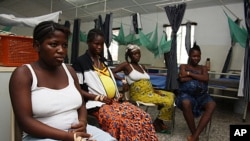It’s estimated there are more than 45 million abortions worldwide every year. Reproductive rights advocates say more than half are unsafe, causing many injuries and deaths among young women. They say protecting adolescent women should be part of the development agenda. The issue was discussed at an event at a Washington think tank.
Many unintended, many unsafe
Leila Hessini is director of community mobilization at Ipas, an NGO working to end preventable deaths and injuries from unsafe abortions. She spoke at a recent event at the Woodrow Wilson Center in Washington, DC.
“Every year, there are 87 million unintended pregnancies. So this is 41 percent of all pregnancies. And this is really a figure that we need to unpack and understand because so much contributes to that. It’s about unmet need for contraception. It’s about sexual violence. It’s about contraception being unaffordable. So there are a lot of reasons that go into this,” she said.
Hessini said 33 million of the unintended pregnancies are among women using contraceptives. She says that means either a failure of the contraceptive itself or in the way in which it’s used.
“Every year there are 46 million abortions. Half of these, 21.6 million, are unsafe. The vast majority of these unsafe abortions are in the Global South. They’re in developing countries. And 30 to 60 percent of adolescent pregnancies end in abortion,” she said.
In sub-Saharan African countries, a high percentage of deaths from unsafe abortions are among adolescent women.
Abortions take place in countries where laws range from allowing easy access to no access at all.
Hessini said, “Forty percent of the world’s women live in countries where abortions are available, what we say, on request. Even though there’s always, as we know, different limitations and restrictions to abortion. Another 26 (percent) live in countries where abortion is only available to save a woman’s life or is prohibited altogether. And those you who follow the abortion debates know that abortions are totally prohibited in certain countries like Nicaragua, El Salvador, Chile, Dominican Republic, Malta and the Vatican City.”
Protection of women needed
Jennifer Redner, a consultant for the International Women’s Health Coalition, said too often basic rights are not protected.
“In too many places, the fundamental right of every woman and girl to control her body simply isn’t recognized. For a girl, control over her body and her sexual life requires more than access to health services. Her most basic human rights – freedom from violence, discrimination and coercion – must be protected both in their own right and to enable her access to services,” she said.
Redner said solutions to the problems are not new. They just haven’t been fully implemented.
“Multi-sectoral programming that works with adolescent girls and their communities to address the multiple barriers that girls face accessing health services, attending school, preventing early marriage, preventing violence and building the economic assets of girls will contribute to our collective goals of ensuring that girls can safely transition to adulthood and can be economically productive members of their community,” she said.
Fiercely debated
Abortion, whether legal or illegal, safe or unsafe, remains a controversial, hotly debated and fought-over issue.
Taryn Hodgson is the international coordinator of the Christian Action Network based in Cape Town, South Africa.
She said, “Firstly, abortion is never safe, especially not for the baby, who is killed in the process. So whether it’s legal or illegal abortion is never safe for the baby. It’s also never safe for the woman. Statistics from the Elliott Institute, who’ve done peer reviewed research into post abortion issues, have found that at least over 60 percent of women are coerced into having abortions.”
She said that coercion comes from parents, husbands or boyfriends. Hodgson says consequences of having an abortion include depression, nightmares and grief. She added legal abortions do not lower maternal death rates.
“Maternal deaths can be prevented with adequate nutrition, basic health care and good obstetric care throughout the pregnancy at delivery and post-partum,” she said.
The Christian Action Network official said this is especially true in many African countries with poor health care systems. As for women having control over their own bodies, Hodgson said, “It’s not a question of whether she should have control over her body. She now has a child, not a choice. The issue of children’s rights, right from conception, needs to be addressed.”
South Africa legalized abortions in 1997. Hodgson says despite that there’s been an increase in illegal or back street abortions because the government has not cracked down on them. What’s more, she says, pills to induce abortion are now readily available on many street corners in South Africa.
She said abortion should be banned under all circumstances, adding that cases in which the mother’s life is in danger are rare. In that case, however, she said the doctor should try to save both lives and not choose who will live.
The Elliott Institute mentioned by Hodgson is in Springfield, Illinois. It says its strategy is to end abortion with compassion. And that the welfare of a mother and her unborn child are inseparable.





